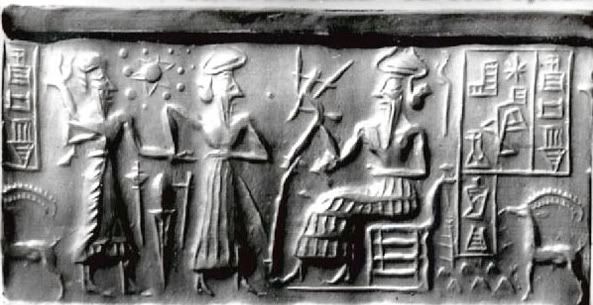Post by Chicago Astronomer - Astro Joe on Mar 21, 2005 0:11:55 GMT -6
In writings of the ancient Sumerians, they write about more than nine planets in the sky. If we are to take this raised relief depiction, there were indeed 10 planets...

This following from a compilation of Sumerians sources:
The ancient Babylonians have long been recognized as the preeminent astronomers of the far, distant past of the ancient world. Several thousands of years before Copernicus they realized that the earth and other planets were spherical and that all revolved around the sun. With this knowledge they were able to accurately predict the eclipses of the sun and the moon. Up until modern times, most scholars assumed that the Babylonians had developed this astronomy themselves, the result of their need to do accurate calculations for their astrology. This however turns out not to be the case. Newly translated Babylonian texts indicate that the position of the stars and planets were calculated instead according to complex equations inherited from the Sumerian civilization.
The Sumerians were also able to measure the distance between stars very precisely. But how is it possible that earthbound, primitive, pretechnological people were able to do this? And even more mysteriously, why? Such star maps would be neccessary for space travellers, but not for the ancient primitive Sumerians. Given the extraordinary accuracy of Sumerian astronomical calculations, perhaps it is prudent to have another look at those areas where their information differs from ours. The Sumerians assign 12 "celestial bodies" to the solar system, the sun, the moon and 10 planets. Today we recognize 11 of these, but it was not always the case. Until the late 18th century Western astronomers only knew of the existence of 6 planets - Mercury, Venus, Earth, Mars, Jupiter and Saturn. Uranus was discovered in 1781, Neptune in 1846, and Pluto in 1930. In this light, is it possible that the Sumerians 12th celestial body is yet to be discovered, a planet that the Sumerins called Nibiru? Interestingly, in 1972 Joseph L. Brady, an astronomer at the Lawrence Livermore Laboratory discovered a pertubation in Halleys comets orbit that could be explained by the presence of a Jupiter sized planet that orbits ever several thousand years. More recently, it has been found that the trajectories of space craft like the Voyagers are being disturbed by an unknown gravitational force.
----------
So much has been lost to the ages of ancient astronomy, only to be re-discovered once again as new. What's the saying....?, "Everything new under the Sun is old".

This following from a compilation of Sumerians sources:
The ancient Babylonians have long been recognized as the preeminent astronomers of the far, distant past of the ancient world. Several thousands of years before Copernicus they realized that the earth and other planets were spherical and that all revolved around the sun. With this knowledge they were able to accurately predict the eclipses of the sun and the moon. Up until modern times, most scholars assumed that the Babylonians had developed this astronomy themselves, the result of their need to do accurate calculations for their astrology. This however turns out not to be the case. Newly translated Babylonian texts indicate that the position of the stars and planets were calculated instead according to complex equations inherited from the Sumerian civilization.
The Sumerians were also able to measure the distance between stars very precisely. But how is it possible that earthbound, primitive, pretechnological people were able to do this? And even more mysteriously, why? Such star maps would be neccessary for space travellers, but not for the ancient primitive Sumerians. Given the extraordinary accuracy of Sumerian astronomical calculations, perhaps it is prudent to have another look at those areas where their information differs from ours. The Sumerians assign 12 "celestial bodies" to the solar system, the sun, the moon and 10 planets. Today we recognize 11 of these, but it was not always the case. Until the late 18th century Western astronomers only knew of the existence of 6 planets - Mercury, Venus, Earth, Mars, Jupiter and Saturn. Uranus was discovered in 1781, Neptune in 1846, and Pluto in 1930. In this light, is it possible that the Sumerians 12th celestial body is yet to be discovered, a planet that the Sumerins called Nibiru? Interestingly, in 1972 Joseph L. Brady, an astronomer at the Lawrence Livermore Laboratory discovered a pertubation in Halleys comets orbit that could be explained by the presence of a Jupiter sized planet that orbits ever several thousand years. More recently, it has been found that the trajectories of space craft like the Voyagers are being disturbed by an unknown gravitational force.
----------
So much has been lost to the ages of ancient astronomy, only to be re-discovered once again as new. What's the saying....?, "Everything new under the Sun is old".
















